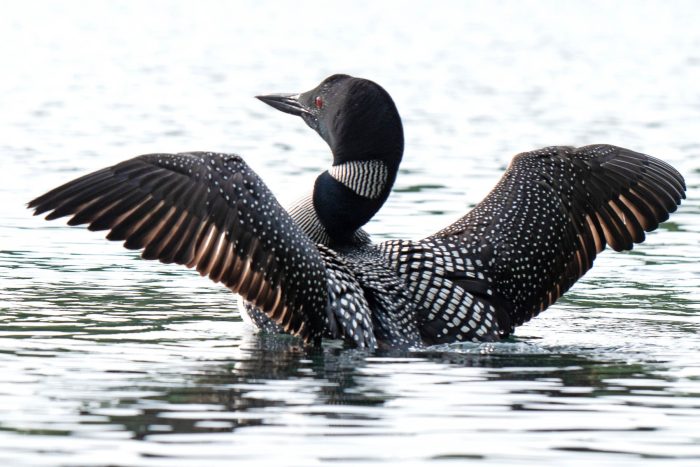Common Loon
Gavia immer
The common loon is a duck-like sea bird with a thick, pointed bill and a distinctive black-and-white checkered pattern during breeding season. It visits the Chesapeake Bay in autumn and late winter to feed on open waters.
This section shows one large critter image at a time. Use the thumbnails that follow to select a specific image to display here.

This gallery contains a grid of small thumbnails. Selecting a thumbnail will change the main image in the preceding section.
Appearance
The appearance of the common loon varies depending on the time of year. During breeding season, loons have a distinctive black-and-white checkered back and “necklace” around the throat. The head and bill are black. In winter, loons have a mostly blackish back and a pale gray bill. The white throat has an irregular black indentation. Loons have a thick, dagger-like bill that it holds straight ahead and large, webbed feet. Their long body grows 28 to 36 inches long, and their wingspan reaches an average of 58 inches.
Feeding
The common loon feeds heavily on menhaden and other small fish. It constantly hunts throughout the day. To find prey, it peers below the water’s surface, then dives below the water to chase it down. Loons feast throughout autumn to hold themselves over during their winter molt, when they cannot swim or fly. When they return to the Bay in late winter, loons once again eat large amounts of fish in preparation for their return flight to the north.
Predators
Adults have few predators, but may be vulnerable to bald eagles and other large raptors. The loon may use its spear-like bill to defend itself against predators.
Flight
In flight, loons have a hunchbacked appearance. They hold their bill straight ahead and their large feet trail behind. Migrating loons have been observed reaching speeds up to 70 miles per hour.
Voice
In winter, loons are mostly silent. During other parts of the year, they make several distinct calls, including a quivering wail. Common loons are famous for their calls, including the "tremolo," which is a wavering call given when a loon is alarmed or to announce its presence. Each male also has a signature yodel, which is its territorial claim; if the male moves to a different territory, his yodel will change.
Reproduction and life cycle
Breeds in Canada and the Great Lakes region of the United States. Males and females will build their nest together in May or early June out of dead plant material, such as sedges and marsh grasses. Nests are claimed with a "yodeling" song and by flying in circles over the territory while sounding loud calls. Females lay two eggs, which are incubated by both males and females for 24 to 31 days. Young can leave the nest at one or two days after hatching and are able to swim at 2 to 3 days old. When small, young will sometimes ride on their parents' backs. They are capable of flight at 10 to 11 weeks old. The oldest-known loon lived at least 24 years.
Did you know?
- Loons can be confused with the double-crested cormorant. You can distinguish a common loon by its spear-like bill, which it holds straight ahead.
- Like most sea birds, loons are very powerful swimmers, but they are clumsy on land because their legs are located far back on the body.
Sources and additional information
- Life in the Chesapeake Bay by Alice Jane Lippson and Robert L. Lippson
- Chesapeake Bay: Nature of the Estuary, A Field Guide by Christopher P. White
- Animal Diversity Web: Gavia immer – University of Michigan Museum of Zoology
- All About Birds: Common Loon – The Cornell Lab of Ornithology
